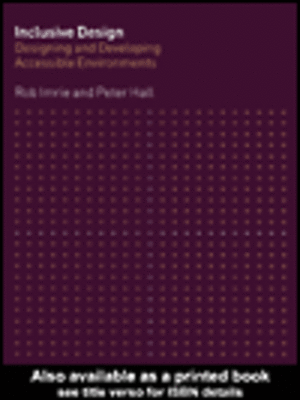
Sign up to save your library
With an OverDrive account, you can save your favorite libraries for at-a-glance information about availability. Find out more about OverDrive accounts.
Find this title in Libby, the library reading app by OverDrive.



Search for a digital library with this title
Title found at these libraries:
| Library Name | Distance |
|---|---|
| Loading... |
The reality of the built environment for disabled people is one of social, physical and attitudinal barriers which prevent their ease of mobility, movement and access. In the United Kingdom, most homes cannot be accessed by wheelchair, while accessible transport is the exception rather than the rule. Pavements are littered with street furniture, while most public and commercial buildings provide few design features to permit disabled people ease of access.
Inclusive Design is a documentation of the attitudes, values and practices of property professionals, including developers, surveyors and architects, in responding to the building needs of disabled people. Legislative and regulatory controls, particularly in western countries, increasingly require development teams to design the built environment in ways which are sensitised to the needs of disabled people. Disabled people are also demanding adaptations and changes to buildings to permit them a greater use of the built environment and, consequentially, a fuller role in society. Such demands are leading to new pressures on the property and building industries with implications for project design, costs, management and related processes. This book documents the way in which pressure for accessible building design is influencing the policies and practices of property companies and professionals, with a primary focus on commercial developments in the UK. The book also provides comments on, and references to, other countries, particularly Sweden, New Zealand, and the USA.
Inclusive Design is a documentation of the attitudes, values and practices of property professionals, including developers, surveyors and architects, in responding to the building needs of disabled people. Legislative and regulatory controls, particularly in western countries, increasingly require development teams to design the built environment in ways which are sensitised to the needs of disabled people. Disabled people are also demanding adaptations and changes to buildings to permit them a greater use of the built environment and, consequentially, a fuller role in society. Such demands are leading to new pressures on the property and building industries with implications for project design, costs, management and related processes. This book documents the way in which pressure for accessible building design is influencing the policies and practices of property companies and professionals, with a primary focus on commercial developments in the UK. The book also provides comments on, and references to, other countries, particularly Sweden, New Zealand, and the USA.







